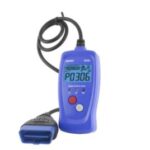In today’s automotive world, understanding your car’s health and performance is becoming increasingly accessible. Gone are the days when complex diagnostics were solely the domain of mechanics with expensive equipment. Now, thanks to advancements in technology, you can tap into your car’s onboard computer system right from your smartphone using a Bluetooth OBDII/OBD2 diagnostic interface. This small, yet powerful tool is revolutionizing how car owners interact with their vehicles, providing real-time data, fault code analysis, and performance insights in the palm of your hand.
A Bluetooth OBDII/OBD2 diagnostic interface is essentially a bridge between your car’s On-Board Diagnostics system (OBDII, standardized in most vehicles post-2000, and some from 1996) and your smartphone or tablet. It plugs into your car’s OBDII port, typically located under the dashboard, and wirelessly transmits data via Bluetooth. This interface, often utilizing the ELM327 chip, allows you to access a wealth of information about your vehicle’s engine, sensors, and overall system health.
The benefits of using a Bluetooth OBDII/OBD2 diagnostic interface are extensive. Firstly, it empowers you to monitor your car’s performance in real-time. Imagine having a customizable dashboard on your phone displaying gauges and charts for speed, RPM, engine temperature, and much more. These interfaces, when paired with compatible apps like Car Scanner, allow you to personalize your data display, focusing on the metrics that matter most to you.
Beyond performance monitoring, these interfaces are invaluable for diagnostics. They can read and even reset Diagnostic Trouble Codes (DTCs), the error codes that trigger your “check engine” light. Instead of being left in the dark about what’s wrong, you can instantly identify the issue, often with detailed descriptions of the fault. Furthermore, features like free-frame data provide snapshots of sensor readings at the moment a DTC was recorded, offering crucial context for troubleshooting. Advanced Mode 06 testing even allows you to access ECU self-monitoring results, helping you proactively identify potential problems and reduce repair costs.
For car enthusiasts and those concerned about emissions, a Bluetooth OBDII interface is also a useful tool. You can quickly check your vehicle’s readiness for emission tests, ensuring you’re compliant with regulations. Moreover, you can monitor all your car’s sensors on a single screen, gaining a comprehensive overview of your vehicle’s operational status.
When selecting a Bluetooth OBDII/OBD2 diagnostic interface, it’s important to choose a reliable adapter. While inexpensive options are available, they can sometimes be problematic, leading to connection issues or inaccurate data. Brands like Kiwi 3, Viecar, V-Gate, Carista, LELink, and Veepeak are generally recommended for their quality and performance. It’s also advisable to avoid adapters marked as v2.1, as these are known to have bugs.
To fully utilize the potential of a Bluetooth OBDII/OBD2 diagnostic interface, pairing it with a powerful app like Car Scanner is key. Car Scanner, as mentioned earlier, offers a wide range of features, many of which are available for free. It supports custom dashboards, extended PIDs for accessing manufacturer-hidden data, and even advanced functionalities like encoding for VAG group vehicles. Whether you’re looking to monitor your fuel consumption, measure acceleration, or simply understand your car better, the combination of a Bluetooth OBDII interface and a robust app like Car Scanner provides an unparalleled level of insight and control.
In conclusion, the Bluetooth OBDII/OBD2 diagnostic interface has democratized car diagnostics, placing powerful tools in the hands of everyday drivers. By providing real-time data, fault code access, and performance monitoring, these interfaces, especially when used with feature-rich apps, empower you to understand your car like never before, leading to better maintenance, informed decisions, and a deeper connection with your vehicle.
